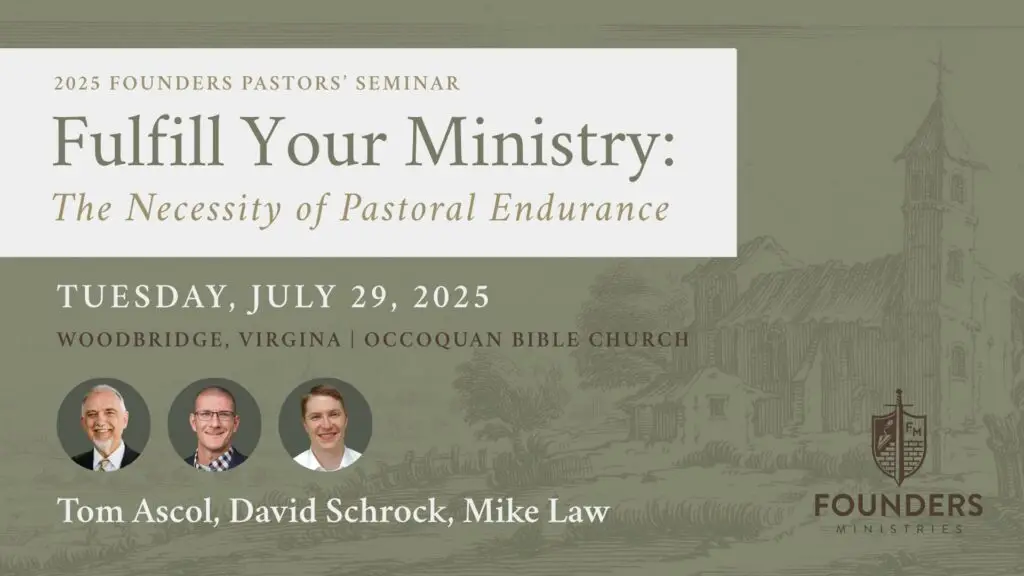If you abandon Eternal Relations of Authority and Submission (ERAS) between the persons of the godhead, will you lose complementarianism as well? Does a commitment to classical trinitarianism undermine or weaken the case for headship and submission within the home? Some may fear that a departure from ERAS opens the door to egalitarianism. Unfortunately, a key figure in the Trinity debates from 2016 serves as anecdotal evidence.
Aimee Byrd allowed Liam Goligher, former Senior Minister at Tenth Presbyterian Church, to publish a critique of ERAS on her blog that ignited the 2016 Trinity debates. Six years after the initial blog post, Aimee was preaching sermons in the gathered assembly on the Lord’s Day. Complementarians may fear that denying ERAS either weakens the case for complementarianism or puts one on a slippery slope to egalitarianism.
I understand the weight of this concern. In 2014, I moved my family from California to Louisville in order to study Systematic Theology under Dr. Bruce Ware, a leading proponent of ERAS and complementarianism, two doctrines I held near to my heart and proclaimed in my ministry. Ware’s commitment to these doctrines was one reason I desired to study under him. After completing requisites for the PhD program, I applied to study with Ware amidst the Trinity debates and was accepted into the doctoral program early in 2017. I no longer share my dear friend’s view of the Trinity, but I still cling to complementarianism, a teaching from which I never wavered.
Am I inconsistent? Must I choose between Byrd and Ware? Does classical trinitarianism break the dam that holds back the waters of egalitarianism? To affirm complementarianism, must I remain committed to ERAS? The answer to these questions is a resounding no!
In order to answer no, one merely needs to demonstrate that the persons of the godhead neither necessitate nor provide an analogy for complementarianism, but I wish to take readers further. Christians ought to embrace complementarianism because of the created order, not the mystery of the Trinity. Other articles in this series contend for classical trinitarianism, contentions I agree with and assume. So, in this piece, I argue that those who hold to classical trinitarianism can, and ought to, embrace complementarianism. To defend this assertion, first, I maintain that our doctrine of the Trinity neither binds us to complementarianism nor provides license for egalitarianism. Second, I demonstrate that the doctrine of creation grounds complementarianism. Third, I look to John Gill as a helpful example of navigating through theological and exegetical reasoning for classical trinitarianism and complementarianism. In short, Christians should be classical and complementarian.
Christians ought to embrace complementarianism because of the created order, not the mystery of the Trinity.
First, the doctrine of the Trinity neither binds us to complementarianism nor provides license for egalitarianism. Complementarians who hold to ERAS and those who become egalitarian because they deny ERAS make a common mistake: they assume the doctrine of God provides a social agenda. Some who hold to ERAS see the Trinity as a blueprint that binds male and female roles, grounding their complementarianism. Others derive their license for egalitarianism from their classical trinitarianism. Both views commit the same error. They assume that the persons of the Trinity provide a blueprint for human relations.
Admittedly, it is easier to see how proponents of ERAS make this mistake. How egalitarians who hold to the classical doctrine of the Trinity fall prey to the same error is less clear. Allow me to explain. Those who think the fall of ERAS frees them to pursue egalitarianism also believed that the Trinity was a social program. No longer seeing their social agenda moored to the mystery of the Trinity, they unfastened from the church’s teaching on the duties of men and women. Neither ERAS complementarians or classical egalitarians properly grounded their views of male and female in the doctrine of creation.
Both views deny that creation supplies a sufficient and stable guide for male and female duties. ERAS proponents commit this error by anchoring their views of male and female to the relations between the persons of the godhead. Attack ERAS and you undermine the duties of men and women. Some complementarians agreed and fiercely held to ERAS. Some egalitarians agreed and felt liberated to preach in the gathered assembly on the Lord’s Day. Egalitarians, like ERAS complementarians, also deny that creation supplies a sufficient and stable guide for male and female duties. Their understanding of men’s and women’s responsibilities shift with the winds of redemptive history and social agendas of the day. Typically, the redemptive work of Christ or social status of women in a particular time and place allow for an ever-shifting understanding of the duties God requires of men and women. For neither view is creation alone able to ground the duties of men and women.
This leads to my second argument. The doctrine of creation grounds complementarianism. Paul exemplifies this reasoning in his argumentation, and we should too. In 1 Corinthians 11:3-16, he reflects on the teaching promulgated by God in and through nature (1 Cor 11:14). Nature teaches the truth that women originate from men and that women are made for men, as Eve was for Adam. Yet, nature also teaches us that men are not without need of women since men come through women, Adam excepted. The woman is from the man and the man comes through the woman. The preposition “from” indicates primacy and authority. All humans are “from” men and all things are “from” God. The principle of origination is evident in the first man and persists throughout creation. As long as humans come “from” men, men will serve as authorities and heads. As long as men come through women, men will depend upon women.
In 1 Timothy 2:11-15, Paul categorically prohibits women from teaching or exercising authority over men in the church. He reasons from the primacy of Adam, from whom Eve comes, which reveals the established pattern of teaching and authority. The pattern is similar to 1 Corinthians 11:3-16. Although Paul brings the fall and redemption to bear on his reasoning, these arguments confirm an already present order given in a good creation that is found in the beginning, persists through the fall, and remains throughout the age of the church. Paul’s reasoning encompasses the first Adam and the consummation of all things by the last Adam.
These texts teach us how to think through our doctrine of God and the duties of men and women by providing two helpful lessons. First, Paul never mentions the persons of the Trinity as the basis for his teaching, contra ERAS. Although the Spirit fills believers to submit (Eph 5:18-21), he does not serve as a model of submission. The name “Son” may imply submission to some contemporary Christians, but we should reject this reasoning. “Son” is one name used to describe the unique relative property of the one who is from the Father. The language of “Word,” and “radiance” fail to imply submission. However, all three words—Son, Word, and radiance—specify that this one of whom we speak is from another. All our language about God is analogical, including the name “Son.” Thus, we ought not to read human notions of father-son relations into the godhead. This move is thoroughly Christian since Trinitarians have always denied the traditional creaturely baggage of time and space that comes with earthly sons, including a heavenly mother. Reading submission into the simple and single will of the Godhead is as mistaken as imputing other creaturely features to the eternal Son.
Nature teaches the truth that women originate from men and that women are made for men, as Eve was for Adam.
Second, Paul argues for the permanent validity of the creation order, contra classical egalitarians. This article is too short to address all the egalitarian objections to these passages, but it is important to note the kinds of objections typically provided. Egalitarians usually appeal unique temporal, cultural, practical, or redemptive aspects in, behind, or beyond the text. But these objections fail for several reasons. First, Paul addresses each epoch of human history from creation, through the fall, in redemption, and until the consummation. Second, he speaks categorically of men and women, indicating the universality of his application. Third, he appeals to representative figures. Adam and Eve stand as figureheads for all men and women. Just as the first woman is from man, so all women are from men. Just as the first child is through a woman so all children are through women. Fourth, Paul provides timeless instructions in the surrounding texts. As we have already noted, 1 Corinthians 11:3-16 reflects on truths taught in nature. In 1 Timothy, Paul provides instructions for prayers in the church (1 Timothy 2:1-8) and qualifications for elders and deacons (1 Timothy 3:1-13), so that the household of God would be properly ordered until the end of the age (1 Timothy 3:14-16). Paul’s prohibition of women teaching and exercising authority in the church continues as long as the church exists, prayers are offered for unbelieving authorities, and the offices of elders and deacons remain in the church. Fifth, Paul highlights unchanging realities that endure until the end of the age. As long as women are from men and men are through women, Paul’s instructions abide. As long as the church of Jesus endures, Paul’s instructions must be followed. Paul’s reasoning precludes any arguments grounded in accidental social situations or upheaval of the natural order on account of Christ’s redemptive work. There is no time, place, or person to whom Paul’s instructions do not apply.
Paul’s reasoning is creational, not trinitarian. When Paul refers to God, it is the one God from whom all creatures originate. When Paul refers to Christ’s redemptive work of grace, it perfects nature while leaving its structural integrity in place. Thus, ERAS proponents fail to find a trinitarian argument for male and female duties and classical egalitarians are compelled to follow God’s prescribed pattern given in creation.
My third, and final, argument comes from John Gill who affirmed classical trinitarian theology and maintained complementarianism. Gill possessed an ability to navigate through a text of Scripture with a keen eye for the rich theology it contained. He also read the Bible theologically. He brought the grammar of the doctrine of God, the persons of the godhead, and the two natures of the Son to bear upon every text he read. Consider 1 Corinthians 11:3, which reads, “But I want you to understand that Christ is the head of every man, and the man is the head of a woman, and God is the head of Christ.” Commenting on this text, Gill writes:
“[God] that is, the father, not as to his divine nature, for in respect to that they are one: Christ, as God, is equal to his father, and is possessed of the same divine perfections with him; nor is his father the head of him, in that sense; but as to his human nature, which he formed, prepared, anointed, upheld, and glorified; and in which nature Christ exercised grace on him, he hoped in him, he believed and trusted in him, and loved him, and yielded obedience to him; he always did the things that pleased him in life; he prayed to him; he was obedient to him, even unto death, and committed his soul or spirit into his hands: and all this he did as to his superior, considered in the human nature, and also in his office-capacity as Mediator, who as such was his servant; and whose service he diligently and faithfully performed, and had the character from him of a righteous one; so that God is the head of Christ, as he is man and Mediator, and as such only.”[1]
Gill rightly accentuates Christ’s assumed human nature which is inferior to the same Son’s divine nature. The inferior human will of the Son submits to the superior divine will of the Father, which just is the Son’s divine will. Gill understands that submission entails two wills, one superior and one inferior, and acknowledges that the Son submitted to the Father by virtue of his human, rather than divine, will. According to Gill’s reasoning, ERAS proponents cannot properly read their theology into texts like 1 Corinthians 11:3.
But Gill also soundly rejects the faulty hermeneutics of classical egalitarians. He denied that women could teach in the public assembly on the Lord’s Day and argued that the usurpation of authority did not merely relate to the pulpit but was grounded in the duties of male and female found in creation. Commenting on 1 Timothy 2:12, he writes:
“Women are not to teach in the church; for that is an act of power and authority, and supposes the persons that teach to be of a superior degree, and in a superior office, and to have superior abilities to those who are taught by them: nor to usurp authority over the man; as not in civil and political things, or in things relating to civil government; and in things domestic, or the affairs of the family; so not in things ecclesiastical, or what relate to the church and government of it; for one part of rule is to feed the church with knowledge and understanding; and for a woman to take upon her to do this, is to usurp an authority over the man: this therefore she ought not to do, but to be in silence; to sit and hear quietly and silently, and learn, and not teach, as in ver. 11.”[2]
Gill rightly concludes that a woman teaching in the gathered assembly usurps the authority of a man, an authority manifested in multiple spheres of life. His commitment to classical trinitarian and Christological doctrines evident in his exegesis does not hinder his ability to rightly affirm male headship in the home, behind the pulpit, and in society. In this way, Gill provides a helpful path forward for Christians who wish to be classical and complementarian.
A commitment to classical trinitarian theology does not require one to abandon complementarianism. We encounter problems only when we assume that the Trinity either binds us to a blueprint for human relations or provides license for our social agenda. Scripture turns our eyes to the stable and sufficient guide for male and female duties. Men like John Gill help us see these truths. Christians ought to be classical and complementarian.
[1] John Gill, An Exposition of the New Testament, vol. 2, The Baptist Commentary Series (London: Mathews and Leigh, 1809), 683.
[2] John Gill, An Exposition of the New Testament, vol. 3, The Baptist Commentary Series (London: Mathews and Leigh, 1809), 286.


































